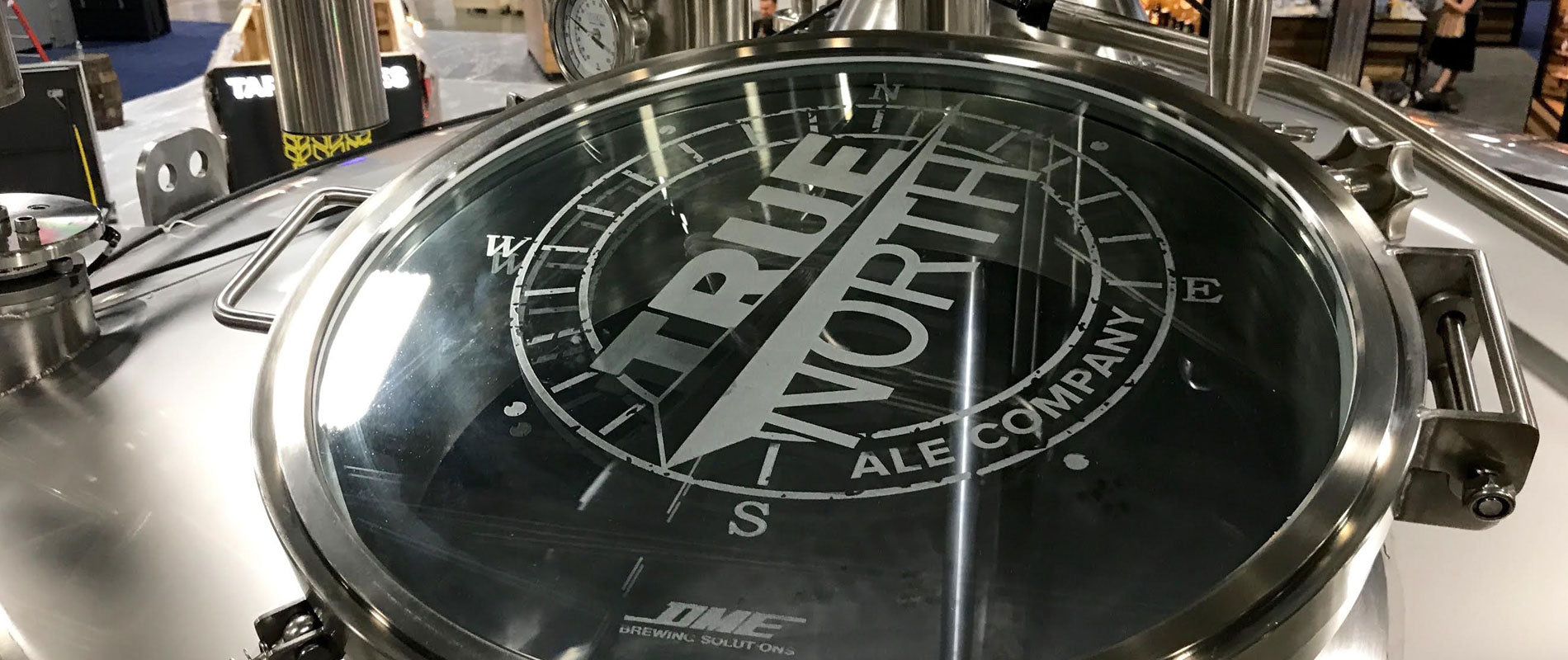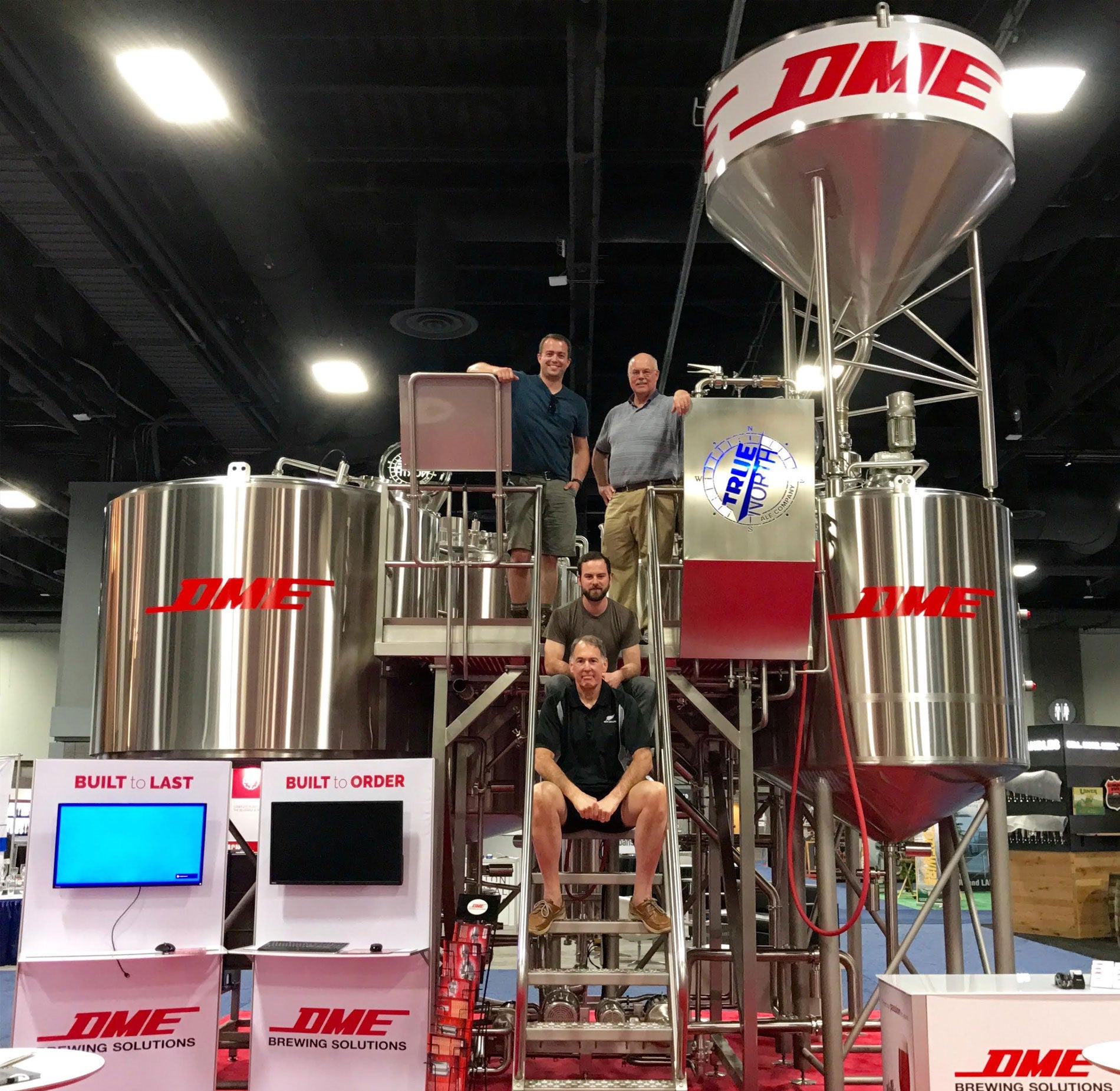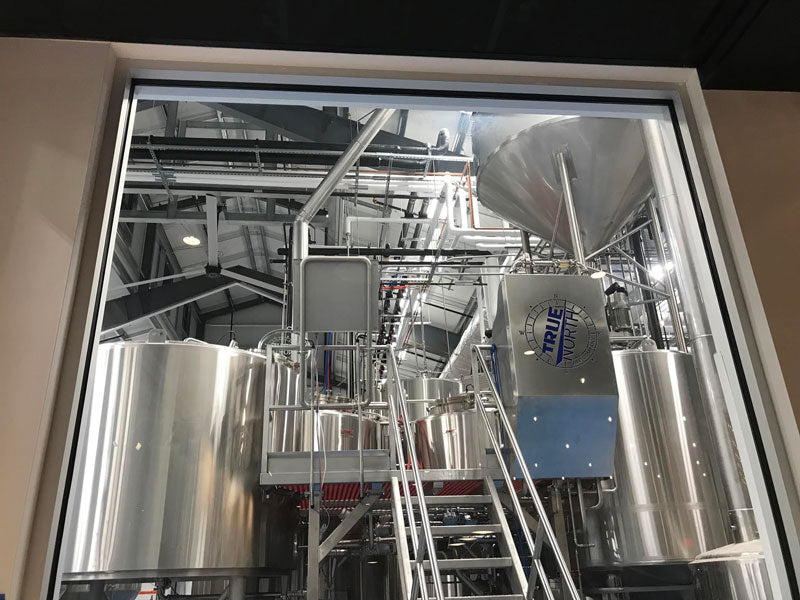Our Facility
Our Brewhouses and Cellar

We at the True North Ale Company are proud to produce our beers on both a 30 barrel (bbl) production brewhouse and a 5 bbl pilot brewhouse. We fill 120 bbl, 60 bbl, 30 bbl, and 10 bbl fermentation and conditioning vessels with core brands and taproom-only beers. When it came time to partner with a fabrication company to design and build our brewhouses and cellar vessels, we chose to go with a world leader — our friends at DME Brewing Solutions on Prince Edward Island in Canada.
Our larger 30 bbl, 4-vessel brewhouse was featured as DME’s conference floor showpiece at the 2017 Craft Brewers Conference (CBC). Together with the engineers at DME, True North Ales worked to customize our system to fit our brewing needs; a mash mixer for thorough mixing of our mash as well as utilization of the traditional process of decoction, a lauter tun designed to maximize our process efficiency, a boil kettle and external wort boiler that allows us to boil gently while also volatilizing unwanted aromatics, and a whirlpool to separate our boiled beer from high hop loads when brewing our IPAs.

As a production brewery, we rely on our larger 30 bbl production brewhouse to produce the vast majority of our beer. These beers come in the form of our core brands you will find in the marketplace in cans and kegs, as well as in our taproom. Our 30 bbl system serves us well in high volume core brand production; up to 120 bbls of beer per day and as many as three batches in production concurrently at any given time during the brewing day.
The 30 bbl system is our lifeblood, while our 5 bbl pilot brewhouse allows us to push ourselves creatively. All recipes must start somewhere, and most often they start on a small scale, where experimentation and adaptation of novel processes and new ingredients are less risky. The pilot system provides us the ability to research and develop new one-off beers. Taproom customers will enjoy experiencing our emerging brews and provide feedback as they progress into the core brand lineup.
As with our brewhouses, we paid close attention to the minor details of our fermentation cellar vessels. These vessels are vital to the production of high-quality beer. They provide our beer a sanitary, closed environment where our carefully selected yeast strains are kept isolated, allowing us very finite control over the fermentation process. We ensure at all points to maintain these clean environments and eliminate the damaging effects of oxygen, allowing us to deliver our beers to you in the freshest, most true-to-form state we have intended.
Independent brewers have moved to cans as the package of choice for fine craft ales and lagers. Cans protect the beer from light damage and no longer impart off flavors, as they did in the past. Cans offer convenience to match the active lifestyles of our customers — they are light, packable, and don't break.
True North Ales has invested in a canning line manufactured in the USA by Palmer Canning. Maximum throughput is 100 cans per minute and it will package both 12 oz and 16 oz cans. Palmer Canning uses counter pressure technology, ensuring very low levels of dissolved oxygen — the bane of canned beer. All True North Ales canned beer found on shelves was packaged on our canning line, by our team, at our Ipswich location.
In order to maintain the integrity of the beer we work hard to produce, our True North Ales team employs various quality assurance and control (QA/QC) checks throughout the brewing process. Whether we are measuring the number of yeast cells in solution to control fermentation, analyzing our product through sensory analysis in taste panels, or testing our water for the correct balance of ions for any style we brew, all decisions at True North Ales are directed and informed by the analysis we conduct every day in our brewery lab. Our investment in state-of-the-art instrumentation ensures the high quality of our beer.
Standing in our on-site taproom you have the opportunity to take a visual tour of our brewery. Directly to the right of the bar is a large window with an excellent view of both our 30 barrel (bbl) and our 5 bbl brewhouses. Grab a pint and read on.

The steep set of stairs in front leads to the work platform for the 30 bbl system, surrounded by the four principal vessels of the brewhouse: from right to left, the mash mixer, lauter tun, kettle, and whirlpool.

The mash mixer is where the grain is mixed with hot water to begin the brewing process. The tall structure atop the mash mixer is the grist case. Crushed grain (barley, wheat, oats, etc.) is transported from the mill room (far right) via an auger system through pipes to the grist case, electronically weighed, then dropped into the mash mixer.
Once the grain is thoroughly mixed with hot water, the mash “rests”, allowing the enzymes in our malted barley to convert starches into sugar. The mash is held at a controlled temperature (typically ~152 degrees Fahrenheit for many beer styles) for 20 minutes to allow this enzymatic conversion, extracting the sugars and proteins required for making beer. After the 20-minute rest, the mash is again stirred and slowly heated through the use of steam jackets within the walls of the vessel. The temperature is raised to ~168 F, where the majority of enzymatic activity is halted. The mash is then transferred to the lauter tun for separation of solids (protein and barley husk) from what brewers call “wort”: the sweet liquid extract that will be fermented and ultimately become beer.
Once in the lauter tun, the wort is briefly recirculated to clarify before it is slowly pumped into the kettle. In the kettle, the wort is boiled for 60-75 minutes. During this time, hops are added to give the brew the flavor and aroma typical to the style of beer being brewed.
At the end of the boil, the wort is pumped from the kettle into the whirlpool. The wort is introduced into the whirlpool at high speeds along the vessel wall. The physical process utilized here is similar to a stirred cup of tea. This aggressive circulation of the wort causes larger particles of hops, protein, and polyphenol (solid waste called “trub”) to drop out of the wort and settle in a tight cone in the center of the whirlpool vessel. Once the transfer of wort to the whirlpool is complete, the wort is left to settle, after which time clear wort can be drawn off the unwanted solids, clarifying but not filtering the wort.
The wort is cooled to room temperature through use of a heat exchanger, then pumped into a fermentation tank, one of the large, stainless steel vessels behind the brewhouse in the “cellar”. Yeast and oxygen are added during the transfer and fermentation begins. During the week long process of fermentation, additional hops may be added in a process called dry hopping. This is typical to our North Shore IPAs.

Following fermentation, the liquid is now called beer, as the yeast has done its job and produced alcohol. The beer is pumped into another cellar vessel, a bright tank. There it is left for a short time so the beer further clarifies, then is carbonated and sent for packaging at the canning line or keg filler.
To the right of the 30 bbl brewhouse is the small set of stairs to the work platform of our 5 bbl brewhouse. This system is simpler, being comprised of two vessels. The mash tun, on the right, combines the functionality of both the mash mixer and the lauter tun of the 30 bb brewhouse. And the kettle, on the left, both boils the wort and has high-speed whirlpool capabilities.
The 30 bbl brewhouse provides the brewing capacity for our core brands that are kegged and canned for distribution to restaurants, bars, and craft beer stores. The 5 bbl brewhouse allows our brewers to create and test new recipes to be served in our taproom.
Now look to your left, through the windows behind the bar. Our canning line can be seen there. It is a mechanical wonder and should keep you entertained as you order another pint.
